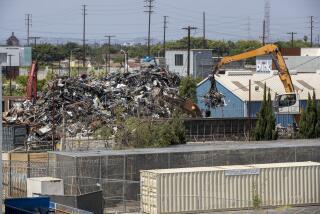Owner of Junkyard Dogged by Neighbors’ Complaints
- Share via
GUILFORD, Vt. — Interspersed amid the alders, birches and hemlocks that line the Green River near its headwaters sit dead Fords, Toyotas and Saabs in various states of disintegration.
Some have doors missing or front ends bashed in, others are in advanced states of rustiness, still others have their hoods raised with remaining engine parts exposed to the weather.
In a few acres of flood plain that lie between the Green River Road and the narrow stream sit row upon row of rusted trucks and automobiles--one neighbor estimated more than 100--and the occasional washer or dryer.
Keith Squires calls it Squires Metal Recycling. Others call it a junkyard. The town of Greenfield, Mass., where the Green flows into the Connecticut, calls it a potential health hazard.
“On an annual basis the town of Greenfield draws approximately 35% of its municipal drinking water from the Green River,” Sandra Shields, Greenfield’s water facilities superintendent, wrote to a Guilford health officer in January. “Preserving high water quality in the Green River is of critical importance to the town.”
Cars and trucks contain toxic chemicals ranging from gasoline and motor oil to antifreeze and the mercury contained in some switches. Linda Lembke, a Squires neighbor and member of the Green River Watershed Preservation Alliance, says her biggest fear is that a flood could sweep through the junkyard and carry pollutants downstream.
The town of Guilford has been after Squires to get the needed local permit; the District 2 Environmental Commission wrote to him recently and told him he needs a state Act 250 land-use permit; and the Department of Environmental Conservation has been investigating Squires’ operation.
But so far, nothing much appears to have changed at Squires’ operation. Squires said he had tried to comply with a request that he keep junk vehicles at least 100 feet from the river’s edge, but acknowledged last month that several junk vehicles still were easily within that distance.
“My phone’s always ringing off the wall,” Squires said. “People want to get stuff picked up. Often it’s the same people who complain about what they see” when they drive past the junkyard.
“I’m overwhelmed by the metal,” he continued. “It comes in faster than it can go out. When you run out of room, you’ve got to find someplace to put it.”
Squires is far from alone in operating an unpermitted and largely unregulated junkyard in Vermont. Gerald McNamara, chief of education and safety in the Department of Motor Vehicles, which has responsibility for regulating junkyards, said there were an estimated 1,200 to 1,300 of them scattered around Vermont.
State law defines a junkyard as four or more abandoned vehicles within sight of a public road. A report prepared last year for the Department of Environmental Conservation put the number of junkyards in Vermont at close to 2,000. But what is unknown is how many of those are simply homeowners’ back-road car hedges, with 1978 cars being cannibalized for parts for 1982 models.
Fewer than 100 places that meet the legal definition of junkyard have the required permit, McNamara said, meaning that well more than 90% of the operations have failed to meet the minimal requirements in current law.
The 1960s law that gave the DMV responsibility for regulating junkyards requires them to be screened from passing traffic by a fence or trees and bushes.
Squires’ operation can be seen clearly from several spots along the Green River Road, and Guilford Select Board Chairman Fred Humphrey said another junkyard in town can be seen plainly from Interstate 91 when trees are bare in winter.
McNamara said the law giving his department responsibility for junkyards does not give it any environmental-law enforcement powers.
The District 2 Environmental Commission, based in Springfield, was the agency that told Squires in July that it was against state rules to operate a junkyard in a flood plain.
“Mr. Squires said he would move the material out of the flood plain to higher ground and put up a fence between the junkyard and the road,” Linda Matteson, the assistant district coordinator, wrote in a July 17 memo. When The Associated Press visited, cars were still near the river bank and no fence was erected.
Recent water tests done for the town of Greenfield found no measurable pollutants in the river from the junkyard.
“I basically can’t figure out why they’re trying to shut me down,” Squires said. “I’ve been doing the same thing for 25 years. Now all of a sudden everybody’s worried about what I’m doing.”
More to Read
Sign up for Essential California
The most important California stories and recommendations in your inbox every morning.
You may occasionally receive promotional content from the Los Angeles Times.













